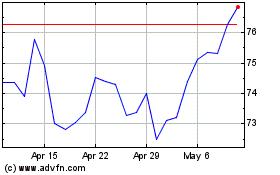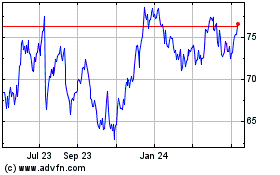State Street Corporation Signs United Nations Global Compact
February 02 2015 - 12:00PM
Business Wire
State Street Corporation (NYSE: STT), today announced it has
become a signatory to the United Nations Global Compact (UNGC), the
world’s largest corporate citizenship initiative. The UNGC is based
on 10 universal principles in the areas of human rights, labor, the
environment and anti-corruption, which closely align with State
Street’s corporate responsibility focus. The UNGC initiative was
officially launched in 2000 to encourage businesses worldwide to
adopt sustainable and socially responsible policies, and to report
on their implementation. State Street joins more than 12,000 other
signatories from companies, governments, labor, and civil society
organizations in approximately 145 countries.
“We are pleased to become an official member of the UNGC
initiative, as its 10 universal principles in the areas of human
rights, labor, the environment and anti-corruption closely align
with our own values,” said Alison Quirk, executive vice president
and chief human resources and citizenship officer at State Street.
“Our membership with the UNGC furthers our focus on these issues
and emphasizes the importance of them to our clients, employees,
shareholders and the communities where we live and work.”
By signing the compact, State Street confirms its support of the
initiative’s 10 principles and its intent to advance those
principles within its organization.
About State Street Corporation
State Street Corporation (NYSE: STT) is one of the world's
leading provider of financial services to institutional investors
including investment servicing, investment management and
investment research and trading. With $28.19 trillion in assets
under custody and administration and $2.45 trillion* in assets
under management as of December 31, 2014, State Street operates in
more than 100 geographic markets worldwide, including the US,
Canada, Europe, the Middle East and Asia. For more information,
visit State Street’s web site at www.statestreet.com.
* Assets under management include the assets of the SPDR® Gold
ETF (approximately $27.3 billion as of December 31, 2014), for
which StateStreet Global Markets, LLC, an affiliate of SSgA, serves
as the distribution agent.
Forward-Looking Statements
This news release contains forward-looking statements as defined
by United States securities laws, including statements relating to
our goals and expectations regarding our business, financial and
capital condition, results of operations, investment portfolio
performance and strategies, the financial and market outlook,
dividend and stock purchase programs, governmental and regulatory
initiatives and developments, and the business environment.
Forward-looking statements are often, but not always, identified by
such forward-looking terminology as “intend,” “expect,”
“objective,” “plan,” “forecast,” “outlook,” “believe,”
“anticipate,” “estimate,” “seek,” “may,” “will,” “trend,” “target,”
“strategy” and “goal,” or similar statements or variations of such
terms. These statements are not guarantees of future performance,
are inherently uncertain, are based on current assumptions that are
difficult to predict and involve a number of risks and
uncertainties. Therefore, actual outcomes and results may differ
materially from what is expressed in those statements, and those
statements should not be relied upon as representing our
expectations or beliefs as of any date subsequent to January 26,
2015.
Important factors that may also affect future results and
outcomes include, but are not limited to:
- the financial strength and continuing
viability of the counterparties with which we or our clients do
business and to which we have investment, credit or financial
exposure, including, for example, the direct and indirect effects
on counterparties of the sovereign-debt risks in the U.S., Europe
and other regions;
- increases in the volatility of, or
declines in the level of, our net interest revenue, changes in the
composition or valuation of the assets recorded in our consolidated
statement of condition (and our ability to measure the fair value
of investment securities) and the possibility that we may change
the manner in which we fund those assets;
- the liquidity of the U.S. and
international securities markets, particularly the markets for
fixed-income securities and inter-bank credits, and the liquidity
requirements of our clients;
- the level and volatility of interest
rates and the performance and volatility of securities, credit,
currency and other markets in the U.S. and internationally;
- the credit quality, credit-agency
ratings and fair values of the securities in our investment
securities portfolio, a deterioration or downgrade of which could
lead to other-than-temporary impairment of the respective
securities and the recognition of an impairment loss in our
consolidated statement of income;
- our ability to attract deposits and
other low-cost, short-term funding, and our ability to deploy
deposits in a profitable manner consistent with our liquidity
requirements and risk profile;
- the manner and timing with which the
Federal Reserve and other U.S. and foreign regulators implement
changes to the regulatory framework applicable to our operations,
including implementation of the Dodd-Frank Act, the Basel III
capital framework and European legislation (such as the Alternative
Investment Fund Managers Directive and Undertakings for Collective
Investment in Transferable Securities Directives); among other
consequences, these regulatory changes impact the levels of
regulatory capital we must maintain, acceptable levels of credit
exposure to third parties, margin requirements applicable to
derivatives, and restrictions on banking and financial activities.
In addition, our regulatory posture and related expenses have been
and will continue to be affected by changes in regulatory
expectations for globally systemically important financial
institutions applicable to, among other things, risk management,
capital planning and compliance programs, and changes in
governmental enforcement approaches to perceived failures to comply
with regulatory or legal obligations;
- adverse changes in the regulatory
capital ratios that we are required or will be required to meet,
whether arising under the Dodd-Frank Act or the Basel III capital
and liquidity standards, or due to changes in regulatory positions,
practices or regulations in jurisdictions in which we engage in
banking activities, including changes in internal or external data,
formulae, models, assumptions or other advanced systems used in the
calculation of our capital ratios that cause changes in those
ratios as they are measured from period to period;
- increasing requirements to obtain the
prior approval of the Federal Reserve or our other regulators for
the use, allocation or distribution of our capital or other
specific capital actions or programs, including acquisitions,
dividends and equity purchases, without which our growth plans,
distributions to shareholders, equity purchase programs or other
capital initiatives may be restricted;
- changes in law or regulation, or the
enforcement of law or regulation, that may adversely affect our
business activities or those of our clients or our counterparties,
and the products or services that we sell, including additional or
increased taxes or assessments thereon, capital adequacy
requirements, margin requirements and changes that expose us to
risks related to the adequacy of our controls or compliance
programs;
- financial market disruptions or
economic recession, whether in the U.S., Europe, Asia or other
regions;
- our ability to promote a strong culture
of risk management, operating controls, compliance oversight and
governance that meet our expectations and those of our clients and
our regulators;
- the results of, and costs associated
with, government investigations, litigation and similar claims,
disputes, or proceedings;
- the potential for losses arising from
our investments in sponsored investment funds;
- the possibility that our clients will
incur substantial losses in investment pools for which we act as
agent, and the possibility of significant reductions in the
liquidity or valuation of assets underlying those pools;
- our ability to anticipate and manage
the level and timing of redemptions and withdrawals from our
collateral pools and other collective investment products;
- the credit agency ratings of our debt
and depository obligations and investor and client perceptions of
our financial strength;
- adverse publicity, whether specific to
State Street or regarding other industry participants or
industry-wide factors, or other reputational harm;
- our ability to control operational
risks, data security breach risks and outsourcing risks, and our
ability to protect our intellectual property rights, the
possibility of errors in the quantitative models we use to manage
our business and the possibility that our controls will prove
insufficient, fail or be circumvented;
- dependencies on information technology
and our ability to control related risks, including cyber-crime and
other threats to our information technology infrastructure and
systems and their effective operation both independently and with
external systems, and complexities and costs of protecting the
security of our systems and data;
- our ability to grow revenue, control
expenses, attract and retain highly skilled people and raise the
capital necessary to achieve our business goals and comply with
regulatory requirements;
- changes or potential changes to the
competitive environment, including changes due to regulatory and
technological changes, the effects of industry consolidation and
perceptions of State Street as a suitable service provider or
counterparty;
- changes or potential changes in how and
in what amounts clients compensate us for our services, and the mix
of services provided by us that clients choose;
- our ability to complete acquisitions,
joint ventures and divestitures, including the ability to obtain
regulatory approvals, the ability to arrange financing as required
and the ability to satisfy closing conditions;
- the risks that our acquired businesses
and joint ventures will not achieve their anticipated financial and
operational benefits or will not be integrated successfully, or
that the integration will take longer than anticipated, that
expected synergies will not be achieved or unexpected negative
synergies or liabilities will be experienced, that client and
deposit retention goals will not be met, that other regulatory or
operational challenges will be experienced, and that disruptions
from the transaction will harm our relationships with our clients,
our employees or regulators;
- our ability to recognize emerging needs
of our clients and to develop products that are responsive to such
trends and profitable to us, the performance of and demand for the
products and services we offer, and the potential for new products
and services to impose additional costs on us and expose us to
increased operational risk;
- changes in accounting standards and
practices; and
- changes in tax legislation and in the
interpretation of existing tax laws by U.S. and non-U.S. tax
authorities that affect the amount of taxes due.
Other important factors that could cause actual results to
differ materially from those indicated by any forward-looking
statements are set forth in our 2013 Annual Report on Form 10-K and
our subsequent SEC filings. We encourage investors to read these
filings, particularly the sections on risk factors, for additional
information with respect to any forward-looking statements and
prior to making any investment decision. The forward-looking
statements contained in this news release speak only as of the date
hereof, January 26, 2015, and we do not undertake efforts to revise
those forward-looking statements to reflect events after that
date.
State Street CorporationAlicia Curran Sweeney, +1
617-664-3001aacurran@statestreet.com@StateStreet
State Street (NYSE:STT)
Historical Stock Chart
From Jun 2024 to Jul 2024

State Street (NYSE:STT)
Historical Stock Chart
From Jul 2023 to Jul 2024
